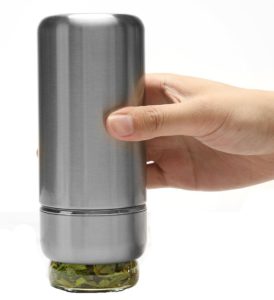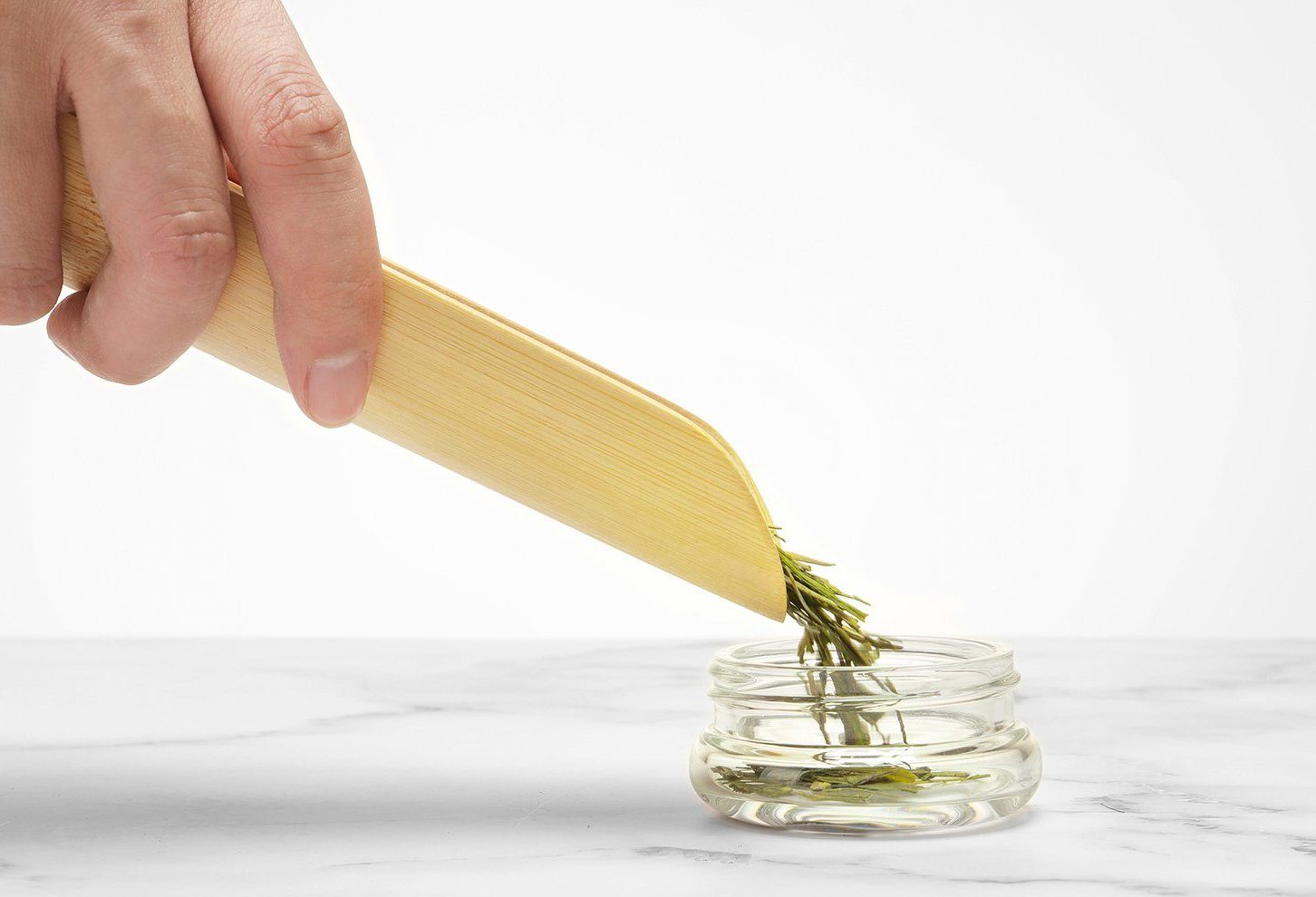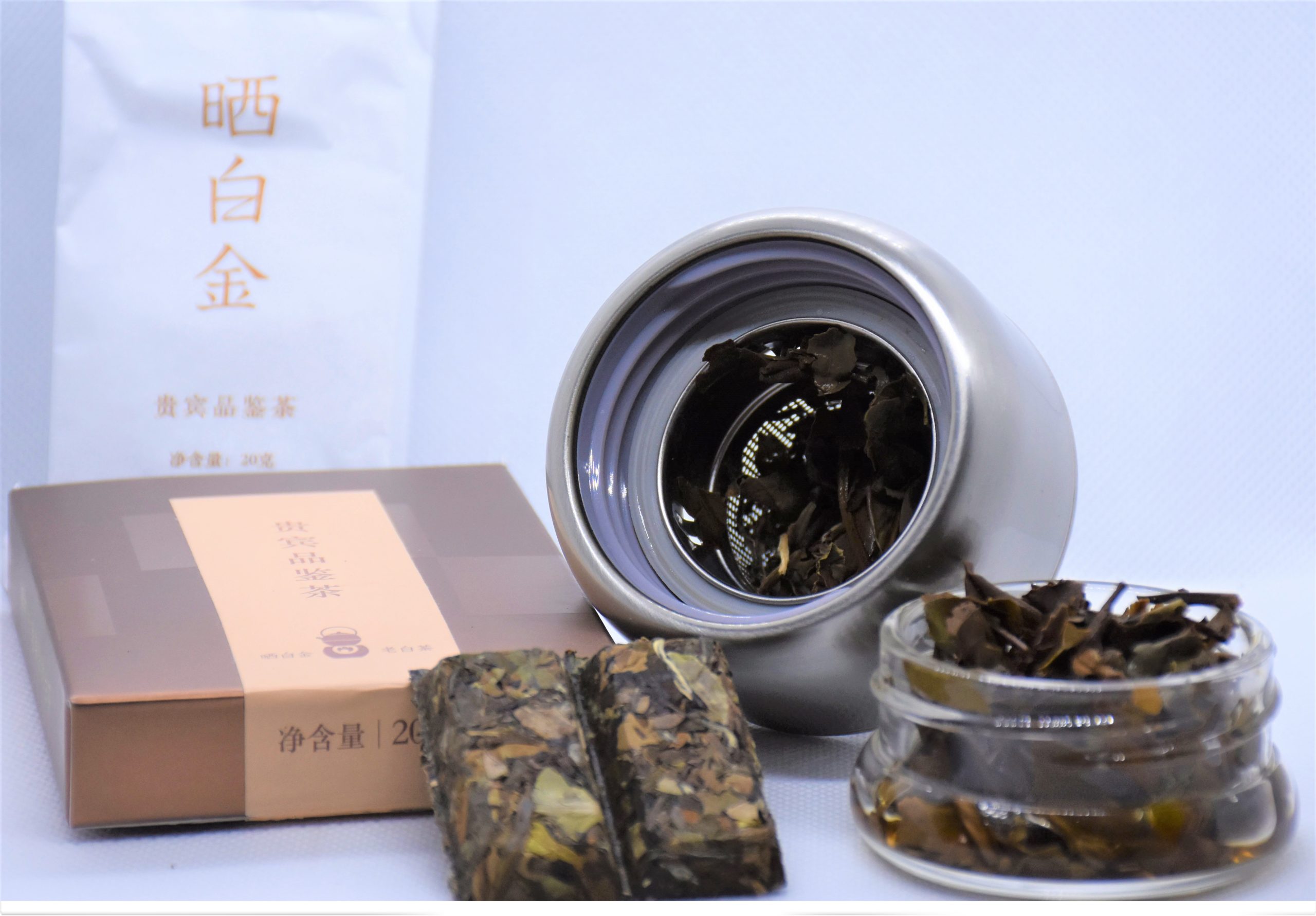
Fine teas reveal their elegance in layers. Rock oolongs, for example, respond to short, controlled steeps in small volumes of water. Teasy offers that level of control with greater convenience and a larger volume than a gaiwan. During the three weeks that I relied on this traveler (alas mainly at my desk due to lockdowns) I found it easy to consistently brew late fall oolongs and spring green teas and my latest tea love, aged white. The traveler excels at putting you in control, a big advantage where oversteeping is a common error.
Here is what I discovered.
Anji Bai Cha
Teasy is quickly pre-warmed, the insulated stainless steel makes pouring 250ml of boiling water comfortably warm to the touch. I used four grams to the cup (250ml) about two tablespoons of leaf but I measure by pinch, not precisely on the scale. The long needles fit comfortably in the removable basket that screws into the top of the brewer. Discarding the boiling water for the first infusion of 160 degrees (70-degrees C) I poured the water through the basket.
Note: 250ml completely immerses the basket and begins the steep but that complicated timing during my 40-foot commute so I learned to use 3.5 grams of tea and 200 ml which brings the water level to the bottom of the basket.
I then traveled from the kitchen to my desk with the Teasy upright, before inverting.
I used this technique because Anji Bai Cha is a quality tea and requires a short steep (always less than two minutes or it delivers a sharp astringent note). Anji Bai Cha is called a white tea but it is actually a green tea made from translucent (white) leaves that yields a mellow, fruity flavor at low temperature and short steeps. I use the tea timer app on my phone the first time or two. The Teasy’s clear brewing chamber is a great advantage. Inverted on the shelf above my keyboard, I could see when the tea was ready to sip. If I erred a bit and the tea was too thin after the second steep, I simply inverted the Teasy for another 30 seconds. Meanwhile, as I sipped, the liquid from the leaves was nicely contained for a no-drip experience. The body of the Teasy has a secure rubber coaster to sit secure on the desk and the lip is nicely rounded for a sip. The double-wall insulation is excellent as the tea remained warm even when I was lost in thought.

Rou Gui (Yancha)
Wuyishan tea makers use much larger and coarse leaves combined with a greater quantity of oolong tea (6 grams) to fill the basket. These teas are roasted, often several times. Unlike the green tea needles, these leaves expanded to press the sides of the basket. Fortunately, the basket is sufficiently deep to permit the free flow of water. Like the green teas, these teas are enjoyed in stages. Here the tea is much more forgiving so I poured the maximum 250ml through the basket (immersing the leaves completely) and inverted at my desk until the tea reached the desired color. I find the second steep the most pleasing with a characteristic cinnamon note and lovely aroma that is not trapped by the brewing apparatus as is the case with many travelers.

Compressed White Tea (Fuding)
An exciting new style of tea, compressed white or aged white tea, has held my fascination since 2017 when I traveled to Fujian to visit Pin Pin Xiang, a manufacturer of delicate whites from Fuding. The tea is pressed into six-gram cakes that fit comfortably in the Teasy basket, expanding over time but never restricting water flow. Whites can be finicky which is why I love the aged white or “golden tea.” The aging process makes the tea tolerant of higher temperatures as much of the tannins are converted to more pleasant tasting amino acids during the processing. The amber tea is remarkable with the fresh aroma of white tea. Known as Lao Bai Cha (old aged white tea) these small cakes can be 10 to 20 years or older but much is sold after three years. These teas are handmade. Since the tea is condensed reducing the amount of tea and water volume is essential. Always rinse the tea to wake the leaves. In the Teasy begin with no more than 125 ml and half a cake (3 grams). The water should be boiling to bring out the polyphenols. No need to worry about scalding or oversteeping, two minutes develops a light amber and three minutes produced a very saturated liquor with full mouth-feel and lingering aftertaste. Eventually, I just tossed in the full 6-gram cake since I prefer the richer liquor but I was careful to keep my steeps short. I found the tea remained robust after five steeps.
The primary advantage of a Teasy is the ability to see the color of the tea as it steeps. Halting the steep is simple. All you need to do is invert the vessel which completely isolates the leaf from the liquor. Taste can be adjusted by the quantity of leaf, temperature over time, and the volume of water. Teasy is not designed to hold more than 250ml or you risk “blowing the top.” This is not a serious flaw, the borosilicate brewing chamber will not splinter, but the spill can be substantial and the initial pop is alarming. This happened only once in three weeks because I overfilled, ignoring a caution against doing so.
 Teasy is compact, it weighs 280 grams and is constructed of insulated stainless steel (SUS304), high-borosilicate glass with food-grade silicone. Hand washes in soapy water. The brewer keeps drinks hot or cold for hours (rated from 0°C to 100°C). The steeping capacity is 300 ml (approximately 9 oz.)
Teasy is compact, it weighs 280 grams and is constructed of insulated stainless steel (SUS304), high-borosilicate glass with food-grade silicone. Hand washes in soapy water. The brewer keeps drinks hot or cold for hours (rated from 0°C to 100°C). The steeping capacity is 300 ml (approximately 9 oz.)
Priced at £35.00 | $40 | www.easy-teasy.com | Harney & Sons
Tea Market
Get More Value from Your Tea: BRU Maker One
+41794574278
Jacque's Organics
(647) 804-7263